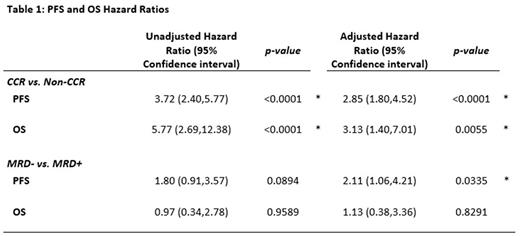Abstract

Introduction: Deep remission to first-line chemoimmunotherapy for chronic lymphocytic leukemia (CLL), especially undetectable minimal residual disease (MRD-), was associated with longer progression-free (PFS) and overall survival (OS). (Kovacs 2016, Kwork 2016) Patients with relapsed/refractory (R/R) CLL represent a more difficult and complex population to treat. The benefits of achieving deep response to second-line therapy in R/R CLL have not been reported. This study aimed to describe patient characteristics, PFS, and OS in patients with R/R CLL who achieved clinical complete remission (CCR) from second-line therapy compared to patients who did not achieve CCR in a real-world setting.
Methods: Patient-level data was abstracted from medical charts by 85 oncologists/hematologists in the United States between April and June 2017. Data were collected for adult patients with R/R CLL who initiated a second-line pharmacological therapy between January 1, 2010 and Augusts 31, 2015. Data on disease progression, mortality, and best response to second-line therapy was reported by the treating oncologists/hematologist; iwCLL 2008 criteria were provided to guide assessment of treatment response. Patients were categorized into two cohorts based on best response to second-line therapy: patients who achieved CCR (CCR cohort) and patients who did not achieve CCR (non-CCR cohort). The non-CCR cohort included patients with partial remission (PR), stable disease (SD) and progressive disease (PD). Sample size for each response cohort (i.e., CCR, PR, SD, and PD) was determined a priori based on distribution of responses seen in clinical trials. PFS and OS were compared between the CCR and non-CCR cohorts using Cox proportional analyses. Exploratory analyses compared outcomes between patients with and without MRD- among those who achieved a CCR or PR and had an MRD assessment. Multivariate models adjusted for potential differences in demographic and clinical characteristics between CCR and non-CCR cohorts (i.e., gender, age at R/R CLL diagnosis, del [17p] status, Rai staging and ECOG status at second-line therapy initiation) and between cohorts with and without MRD- (i.e., gender, age at R/R CLL diagnosis, chronic renal failure, and ECOG status).
Results: Data was collected on 306 patients with R/R CLL - 153 patients with CCR and 153 patients who did not achieve CCR (102 patients with PR, 40 with SD, and 11 with PD). Most common regimens received in second-line therapy were novel targeted therapies (CCR cohort: 42.5%; non-CCR cohort: 52.3%) and combination of rituximab and bendamustine (CCR cohort: 27.5%; non-CCR cohort: 19.6%). Most patients were male (70.6%). Patients in the non-CCR cohort were older (median of 66 vs. 63 years old) than patients in the CCR cohort; a higher proportion of patients in the non-CCR cohort had a Rai stage of III-IV (62.1% vs. 50.3%), an ECOG status of 2+ (33.9% vs. 13.1%), and del (17p) (26.1% vs. 13.1%) at second-line therapy initiation compared to the CCR cohort. The median observation period after second-line therapy initiation was 26.8 months in the CCR cohort and 23.1 months in the non-CCR cohort. Compared to patients in the CCR cohort, patients in the non-CCR cohort had an over 2-fold higher hazard of progression/death (adjusted hazard ratio [HR]=2.85, p<0.05) and an over 3-fold higher hazard of death (adjusted HR=3.13, p<0.05). Among patients who achieved CCR or PR (n = 255), 78 patients achieved MRD- and 86 patients did not; 13(17%) patients who achieved MRD- and 23 (27%) patients who did not achieve MRD- progressed/died. Patients without MRD- had an over 2-fold higher hazard of progression/death (adjusted HR=2.11, p<0.05) compared to patients with MRD-. Overall survival was not significantly different among patients with an MRD assessment.
Conclusion: Results from thisreal-world study suggest that among patients with R/R CLL, achieving deep response in second-line treatment is associated with improved PFS and OS. Given the findings from this study, achieving deep response should be considered as an endpoint for treatment in patients who are receiving first salvage therapy.
Wierda: Genzyme: Consultancy, Honoraria; Pharmacyclics: Consultancy, Honoraria, Research Funding; Janssen: Research Funding; The University of Texas MD Anderson Cancer Center: Employment; Kite: Research Funding; GSK/Novartis: Consultancy, Honoraria, Research Funding; Acerta: Research Funding; Karyopharm: Research Funding; Merck: Consultancy, Honoraria; Gilead: Consultancy, Honoraria, Research Funding; Sanofi: Consultancy, Honoraria; Juno: Research Funding; Emergent: Consultancy, Honoraria, Research Funding; AbbVie: Consultancy, Honoraria, Research Funding; Celgene: Consultancy, Honoraria; Genentech/Roche: Consultancy, Honoraria, Research Funding. Gauthier: AbbVie Inc.: Other: I am an employee of Analysis Group Inc., which received consulting fees from AbbVie for this study; Analysis Group, Inc: Employment. Meissner: AbbVie Inc.: Employment, Equity Ownership, Other: I am an employee of AbbVie, Inc and may own AbbVie and/or Abbott stock. Guerin: Analysis Group, Inc: Employment; Novartis: Other: I am an employee of Analysis Group, which received consulting fees from Novartis; AbbVie Inc.: Other: I am an employee of Analysis Group, which received consulting fees from AbbVie . Samp: AbbVie, Inc.: Employment, Equity Ownership, Other: I am an employee of AbbVie, Inc and may own AbbVie and/or Abbott stock.
Author notes
Asterisk with author names denotes non-ASH members.

This icon denotes a clinically relevant abstract


This feature is available to Subscribers Only
Sign In or Create an Account Close Modal